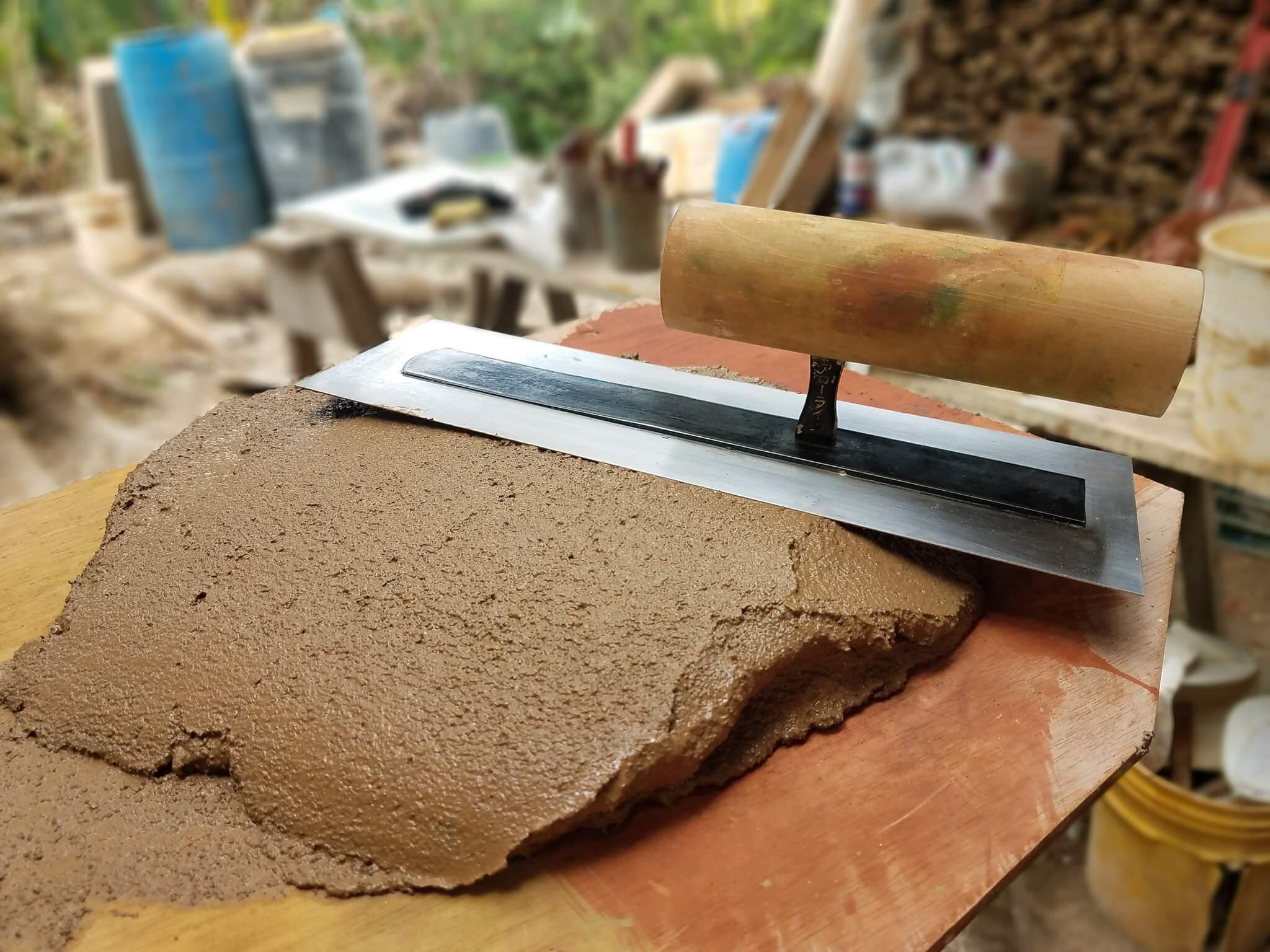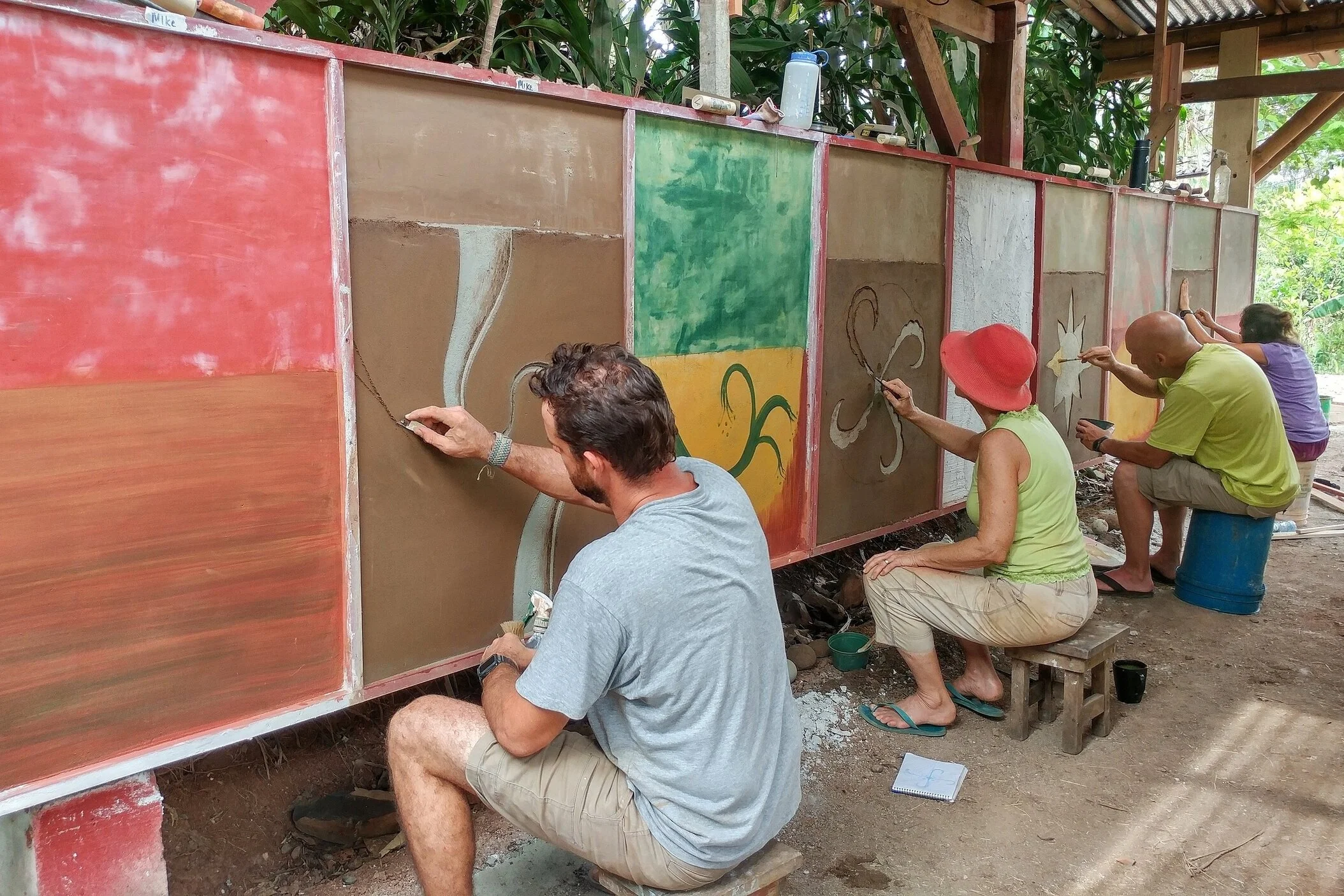Lime Plasters Are In
By Anthony, Apprentice 2020
Plastering is an ancient tradition in the building trades that continues to hold cultural importance in modern times. Amongst the typical plasters that can be found in the building world include clay, gypsum, portland cement, and the focus of today’s blog, lime. The rich history of the use of lime in the plastering trades can be traced back to all continents. Of particular note are the styles that have emerged from Italy and Morocco, as well as the beautiful examples that are found in Japan and the ancient Mayan temples of Mexico. This craft is experiencing a resurgence through the increased global interest in natural building.
A clay carving with a lime fresco background
Tadelakt (water resistant lime plaster) shower- Read our blog about how to make an earthen/tadelakt shower
Why people love Lime Plasters
Lime plastering as a craft form has endured the test of time due to its versatility and the accessibility of limestone as a building material. When produced and applied with care and experience, lime plasters yield an elegant finished product. Some of the many benefits of using lime include high vapor permeability (‘breathability’), flexibility, autogenous healing, stickiness, and durability. Perhaps of greatest interest is the ‘breathability’ factor, which contributes to drying interior spaces and the general avoidance of condensation inside buildings. Additionally, where other stiffer plasters, such as cement, might fail due to the formation of large cracks, flexible lime plasters have the unique characteristic of self-healing (‘autogenous healing’) with which micro-cracks are naturally filled with ‘free lime’. This contributes greatly to the durability of ancient structures, particularly in seismic zones.
Hawk and trowel
Overview of the Lime Cycle
Understanding the benefits of using lime in our buildings, let’s review the source of these plasters by exploring the lime cycle. Our desired binder begins as calcium carbonate in the form of limestone, coral rocks, or sea shells. This base material is heated to around 900°C (a ‘cherry-red heat’) where it undergoes a chemical change by giving off carbon dioxide gas and forming calcium oxide (quick lime), a highly reactive, dangerous compound. Don’t mess with it. From here, quick lime is hydrated by combining it with water and calcium hydroxide is formed. At this point, our hydrated lime is being prepared for final application by slaking it, that is, to be stored in water. Once we are ready to use this hydrated lime, it is prepared in a mix with aggregate and fiber, according to our desired use of the plaster. Generally, multiple coats are applied with each successive layer receiving a thinner application. The final layer, or our finish coat, can be applied as thin as 1/16th of an inch, or even less.
Lime Plaster Finishes
There are many ways that lime plasters can be applied to create different visual and textural effects. This is where the magic happens. Some of the well-known finishes include frescos, venetian plasters, lime wash paints, and tadelakt. All require a detailed attention to the timing and moisture levels during their application.
Benito Steen stoning our tadelakt shower
Fresco design
Learn Lime Plastering in Natural Building Workshops in Costa Rica
The annual Natural Building Workshop at Rancho Mastatal in Costa Rica is focused on developing simple and elegant wall systems for sustainable homes using readily available natural materials. The course focuses on Natural Building techniques, such as wattle and daub, adobe bricks, cob, earthen floors, and the mixing and application of multiple kinds of plasters, including clay and lime. Workshop attendees have the opportunity to learn from some of the most experienced natural builders in Costa Rica, and to develop their skills in creating elegant lime plaster finishes such as tadelakt, fresco, and venetian plaster. This year’s course was attended by people from more than 10 countries, and was just as diverse in its variety of natural building techniques demonstrated.
Students practicing different plasters and techniques during our annual workshop
Pigments, fibers, sands, and more
Want to learn more?
Hope you feel inspired to begin learning the ancient art of lime plastering. You can really beautify and add special touches to your home and spaces with a variety of different lime plastering techniques.
If you want some hands on practice and instruction, sign up for our annual Natural Building Workshop.
Also check out Benito Steen’s YouTube channel all about natural building techniques.
Stay tuned for the wide array of upcoming courses conducted at Rancho Mastatal in Costa Rica.
Check out these past blog articles about natural building techniques we practice and teach:
How to Make an Earthen Floor for Your Sustainable Home
Natural Building & Clay Carving: Add Artistic Expression to Your Home









